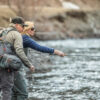Synopsis
The leaves are beginning to turn color here in the Valley making for a gorgeous autumn experience. The weather is switching back and forth between Indian summer and cooler fall days, but either type makes for a great day on the water. Anglers need to stay prepared with warm weather gear, as well as cool weather gear, including a rain jacket and fingerless gloves. With few other anglers and great weather, this is a fantastic opportunity to get out on the water and enjoy the combination of quietude and rising fish.
Silver Creek
The Callibaetis are putting on a show for the afternoon anglers and people are raving about how good the fishing has been. Currently things get rolling in the late morning, peak in the afternoon, and an angler can still be home for dinner. This is not to say that the morning and late evening activity isn’t worth while. Anglers taking advantage of these time frames are going to have a lot of water to themselves. We are still in a terrestrial time of year, so don’t put away those Hopper, Ants and Beetles yet! Keep an eye on the weather this week, daytime thunderstorms mean cloud cover and this could bring the fall Baetis off in a big way. Be ready for it with some seriously small Baetis flies, all the way down to a size 20 and 22.
Big Wood River
Much like Silver Creek, as soon as we get some cloud cover, the fall Baetis are going to begin putting on a show and really get the fish fired up to dine off of the surface. There have already been blanket hatches of this insect in the 2:00 p.m. to 4:00 p.m. time frame. The Western Red Quill is still active and if the fall hatches continue to the early trend like most of the bugs this summer, expect to start seeing the October Caddis. If this is the case, anglers can get the Stimulators they put away a month ago back out and begin searching the water. The most important thing to keep in mind this time of the year is where you fish the pools. This is dictated by the insects that are dominant at any given time of day. Flat water is where you find fish on the Baetis, riffle water is where the Quills will be, and the October Caddis will pull fish up from the shallowest flats that have good rocky structure in them. Enjoy the fall colors!
Upper Lost and Copper Basin
This area is still producing some great fishing and very, very little angling pressure. Big fish are being taken from the swifter, deeper sections from the Main river all the way up through the East Fork. You may find a drop in size as you move higher up, but still lots of great action. Hoppers are a great bet up there right now, as well as small attractor patterns fished tight to overhanging limbs and around submerged boulders. The majority of the fish are being taken subsurface with small Pheasant Tail Nymphs and Prince Nymphs.
Big Lost River
The Lost is producing well below the Dam and anglers can take fish on Hopper patterns as well as Chernobyl Ants. Baetis are the most prominent hatching insects and small Parachute Adams as well as Gulper Specials are all one needs to fool the fish coming up for these events. Small Pheasant Tail Nymphs and San Juan Worms are great subsurface patterns when the fish aren’t rising, or to target slightly bigger fish. At the current flows, wading is excellent and there is great opportunity to sight nymph on the edges of currents and at the heads of buckets. Take your time when moving through the river and look for big fish lying in the open under slightly disturbed, moving water.
South Fork of the Boise
The flows on the South Fork of the Boise have dropped a lot over the past few days. This means good news for wading anglers that have been waiting for lower, more wadable flows. Get on the river with your favorite Fall Baetis patterns and even some Pink Alberts, then get ready for some outstanding fishing. Hoppers are also a good bet when the fish aren’t rising. If you need to go subsurface, try Red Squirrel nymphs, Prince nymphs, and drop small Pheasant Tails nymphs behind them. Concentrate on waist deep riffles when the fish aren’t on the surface and look at the glassy flats and banks when the hatches get revved up!



